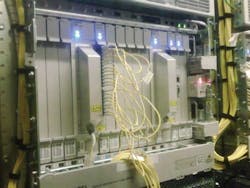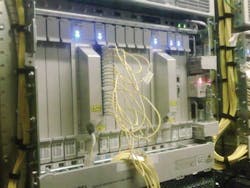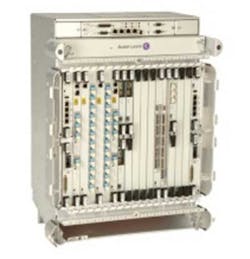By Meghan Fuller Hanna
Systems vendors traditionally have relied on MSA-based modules to help reduce costs. Now, control of the complex electronics required for coherent detection at 40G, 100G, and beyond may make a “do it yourself” approach more appealing.
On May 20, 2010, Cisco announced its intent to acquire optical module and electronics manufacturer CoreOptics, signaling a sea change in the relationship between systems houses and transponder vendors, say some analysts. (Cisco completed the deal the following July.) In the past, equipment vendors relied on MSA-based modules to help reduce their costs, making Cisco’s move a bit puzzling, particularly since it led the MSA charge at 10G. But CoreOptics’ expertise is really in the digital signal processing (DSP) required for coherent detection at 40/100G.
Complex electronics—including DSP, high-speed, analog-to-digital conversion (ADC), and forward error correction (FEC)—are the gating factor for coherent approaches to 40/100G. Several systems vendors, Cisco included, have seemingly decided it’s in their best interest to retain this functionality in house. If this is true, where does that leave the module suppliers?
Systems houses control DSP, but for how long?
With the acquisition of CoreOptics, Cisco can add its name to a short but growing list of systems houses who have already introduced internally developed 100G coherent systems or announced their intention to do so. The vendors include Ciena/Nortel, Alcatel-Lucent, Huawei, and Infinera.
Nortel, now part of Ciena, installed the first commercially available 100G system for Verizon last year. It used homegrown electronics—and marked the start of a trend in systems design. Source: Ciena photo
Those systems houses will bypass the optical module vendors and the IC suppliers and use their own expertise for coherent detection. In a research note entitled “Optical system and module vendors rush to grab 100G expertise,” author Karen Liu, vice president of components at Ovum, poses two key questions: “Who is best able to take ownership of the DSP? And for whom is it most critical to take ownership?”
The answers to these questions are different, she says. Ovum believes the systems houses are best able to take ownership of the DSP, but there is more incentive for the optical module vendors to do so.
As Liu sees it, the systems houses already control the complex electronics required for coherent detection; the more salient question is how long will they continue to do so? Historically, OEMs have developed critical technology in house because they wanted to make sure they get it right or because the technology was not yet available from a third party. Then, to reduce the cost of future generations of equipment, they relinquished control of that technology to the merchant market.
“In my mind,” says Liu, “it’s not a question of whether they will take ownership; I think they already have, by and large. The question is, is that a permanent move or is it a temporary time-to-market [move]?”
For Niall Robinson, vice president of marketing at Mintera Corp., the situation unfolding in the coherent market seems familiar. In the mid to late 1990s, when 10G was still in its infancy, “we had this new thing come into terrestrial transport that the submarine market had been using for a while,” he recalls. “It was called forward error correction [FEC].”
Nortel led that charge as well, developing a “soft FEC” that leveraged unused overhead in the SONET frame to add FEC capability. Though it provided only a few decibels of optical signal-to-noise ratio (OSNR) improvement initially, the industry recognized how important FEC could be for terrestrial applications.
“And what did everyone do?” posits Robinson. “They did exactly what is playing out again with coherent. They went away and developed their own FEC because there were no chips to buy on the market. So all the products to hit the market, day one, were home-grown, proprietary solutions,” he explains. “But ask any systems house today, ‘Do you make your own 10G stuff?’ Everybody buys it externally.”
Robinson expects the same scenario to play out with coherent detection. The systems houses will continue to develop complex electronics in house, probably for the next three or four years, he says. But eventually, the technology will become “fairly commonplace” and offerings will begin to appear from third-party vendors. “And people will start shifting over to those modules because they’ll be lower cost than building their own cards with very little performance differentiation.”
One indication that Robinson may be right: ClariPhy Communications’ cofounder and CEO Paul Voois spoke recently with Lightwave’s editorial director Stephen Hardy about his company’s latest round of funding, which will be used to develop 40/100G DSP ICs. In addition to Oclaro, which contributed $7.5 million, other investors included “multiple telecom OEMs.” While Voois declined to name names, he did reveal that those investors are, in fact, systems houses.
Alain Couder, CEO of Oclaro, agrees that the DSP capability will not remain the sole domain of the systems houses. “The number of companies that can afford to do their own transponder will be going down,” he said in a conversation with Lightwave shortly after the partnership with ClariPhy was announced. “And you see that right now. Most of the Tier 2 companies are buying modules, while the Tier 1 companies are buying modules at 10G — not all of them, but some at 10G — but most of them do their own 40G and 100G. All of that is going to evolve. I think we’ll see less and less people doing their own module — if [optical module manufacturers can deliver] the right module with the right performance.”
Liu, by contrast, is not entirely convinced this scenario will play out. Thanks in part to the Optical Internetworking Forum’s efforts, there seems to be “remarkable clarity and agreement” about how to implement 100G, but “the kicker in my mind is that it’s not a straightforward turn of the crank going forward from 100G,” she says. “Discussions about 400G and a terabit are technically all over the map.” Because of this technical uncertainty in the road ahead, systems houses may want to retain ownership of the electronics, she says.
“Let’s say 100G matures,” Liu continues. “They wouldn’t turn that [expertise] over because they are actually going to need that effort to help them with 400[G and beyond]. That would be the thing that changes this from a purely economic [decision]; ‘Okay, I’ve got this design working. Now I can send it out.’ It’s the fact that [the DSP expertise] has a tie-in to the whole roadmap and the need to have that in house.”
Liu wonders whether this is a lesson the industry learned from Nortel. “When Nortel came out with [coherent detection at 40G], everyone suddenly realized that they had kept a capability, and suddenly they could do it. I think that’s potentially a wake-up call. You can’t wait for vendors to come out with this stuff; you have to control it.”
Optical module vendors optimistic
For their part, Oclaro and Mintera remain optimistic about the potential market opportunity for them and other module vendors. They cite the high cost of ASIC development as a key reason why systems houses will eventually turn to the merchant market.
“Honestly, I’m not sure there’s a real positive business case on developing your own ASIC,” Robinson notes. “If these things take $15 [million] to $20 million at best to develop, you’d have to sell an awful lot of systems to really start to recoup that. And I think some of the ASICs that are coming to market now have taken more than one go at getting the ASIC right, so my guess is that their development costs are significantly higher than that.”
Oclaro agrees that developing high-speed electronics in house may prove cost-prohibitive for systems houses. “We think that over time, the price of developing very high-speed electronics will increase,” Couder asserted in the conversation mentioned previously. He argued that “a chipset that has been designed to be pre-tested, pre-designed with optical components [like the one Oclaro is currently developing in partnership with ClariPhy] can save time to market for some of the people who currently are doing their own chips.”
Still, Liu believes the optical module vendors have a tough road ahead. In her research note, she maintains that “their product must address the optical link requirements of multiple OEM designs, which themselves must be tailored for different carrier networks. In addition, they face harsher density and thermal requirements than OEMs designing linecards from discrete components.”
But where one person sees challenges, another sees opportunity. Vladimir Kozlov, founder and chief analyst at LightCounting (see our Interview on page 8), shares the optical module vendors’ glass-half-full perspective, arguing that systems houses may become less reliant on standard modules now.
“If system vendors decide on different approaches to 100G technologies and they design their DSP for a specific protocol, then they may require a specific kind of transponder to go with it,” Kovlov muses. “So instead of shipping a standard module to all the customers, transceiver vendors would have to make custom-made devices, which is actually going to be very good news for transceiver vendors because they will be able to charge much more for custom-made modules than standard ones.”
Regardless of which suppliers end up controlling the high-speed electronics market, Kozlov believes Cisco’s acquisition of CoreOptics is a positive development for the industry overall, as it signals Cisco’s commitment to the 100G market.
“If you look back 10 years,” he says, “40G was supposed to be right around the corner. In my opinion, it is still just emerging from around the corner. So the question is, are we going to have to wait another 10 years for 100G to come, or is it going to happen sooner than that? With Cisco’s [acquisition of CoreOptics], I think there’s a good chance we won’t have to wait another 10 years for this to really happen.”
Meghan Fuller Hanna is a senior editor at Lightwave.


